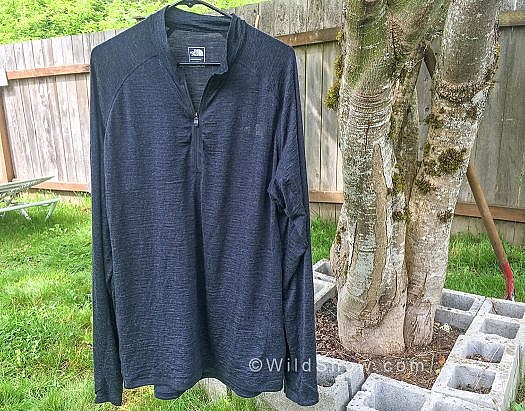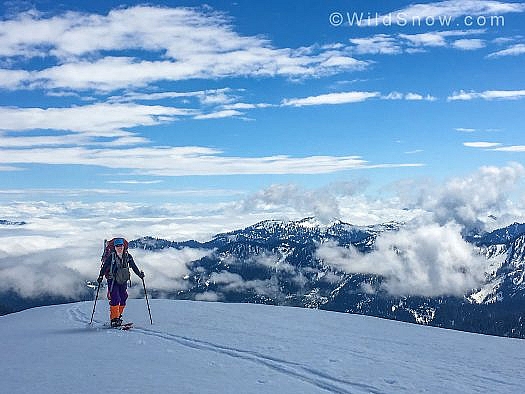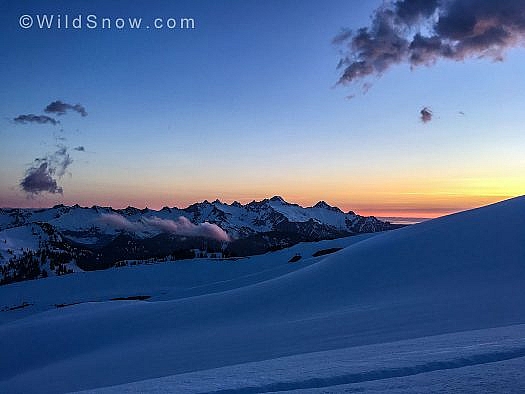Leif Whittaker
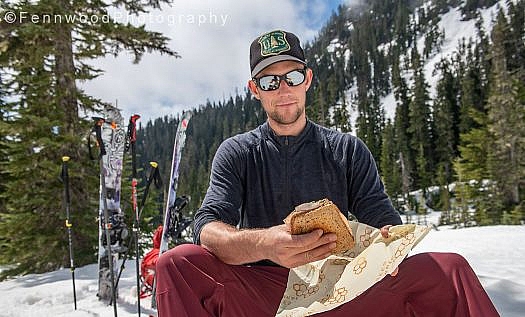
Lunch break in Rocky Creek drainage. Photo by Fennwood Photography
A good way to test a baselayer is to hike fast on a hot day, sweat profusely until the layer is soaked, and then stop, lower the air temperature by 20 degrees, and see if you stay warm. On an overnight trip to Mount Baker’s Squak Glacier, I did that exact thing.
My partner, Freya, and I parked where the snow began about two miles from Schreibers Meadow trailhead. The early May morning was foggy and cool, a respite from the unseasonable heat Washington had been experiencing recently.
Snowmobiles jetted past as we skinned up the road. The whine of the engines dissipated and we heard the low-pitched whoomp-whoomp-whoomp of a grouse. My backpack, loaded with extra gear for training purposes, dug into my shoulders and hips, but it was not an unwelcome discomfort. I’d be on Denali in two weeks and needed all the preparatory suffering I could get.
The fog lifted as we made our way through the meadow and turned northerly, following Rocky Creek drainage rather than sticking to the summer trail. We stopped for lunch in the shade of a mountain hemlock. When we began hiking again I had an urge to push myself, so I gradually quickened the pace until sweat dripped down my forehead, washing sunscreen into my eyes.
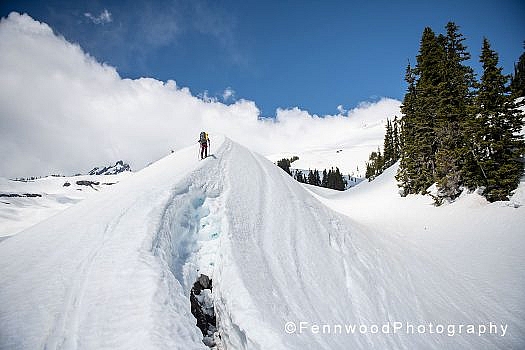
Skinning up the moraine edge toward the Squak Glacier. Photo by Fennwood Photography
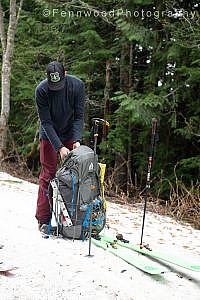
Packing a heavy overnight bag, wearing the TNF baselayer. Photo by Fennwood Photography
Our primary objective was to camp that night and ski the glacier in the morning, but I also wanted to test some clothing and gear to see if they would work for Denali. I was particularly interested in a merino wool long-sleeve zip-neck baselayer from The North Face.
I’m partial to merino wool for many reasons and I wear it often, but I usually stick to brands that specialize in wool. In the past, I’ve found that merino clothing from larger brands with more diverse material and product lines isn’t as comfortable as clothing from wool specialists. In other words, all merino is not created equal.
However, I must say, the long-sleeve baselayer from The North Face is one of the most comfortable and functional merino layers I’ve used. The internally taped seams and bonded collar eliminate chafing, and a band of elastic in the cuffs and hem hold the garment in place and make it easy to roll up your sleeves if you need to cool off.
Little features like these do a lot to improve a piece of clothing, but the most important thing with merino is the quality of the fabric, and in that regard, this baselayer does not disappoint. It’s the perfect thickness for the foundation of a layering system, has zero odor, and is so smooth I wish they made underwear.
One issue I’ve noticed is that, after several washes, the fabric is showing a slight bit of fuzziness, but this is mostly an aesthetic concern and hasn’t affected performance. The forearm area has also become a bit looser than it was when brand new and it remains to be seen how the fabric will hold up to a month of frequent use.
Wool’s moisture control qualities became apparent as I charged up the Metcalf Moraine to the top of a snowy hill at about 6000 feet, where we planned to camp. I had been moving fast for two hours. The panel of my backpack was drenched with sweat, as were my feet, but my upper body felt amazingly dry. As a crisp wind picked up out of the east, I didn’t feel the chill of damp cloth on my spine. I stayed warm instead.
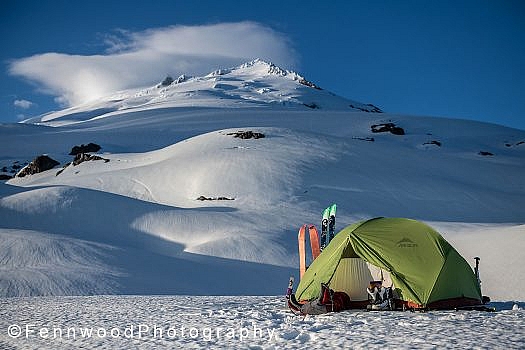
Our camp below Mount Baker’s Squak Glacier. Photo by Fennwood Photography
We built camp, cooked macaroni and cheese for dinner, and watched sunset paint the North and South Twin in brilliant gold light.
As night crept in, the wind strengthened. By 1:30 a.m. it was buffeting our tent with 40 m.p.h. gusts. On the windward side, I braced my arms against the nylon walls and held on.
At first, there were moments of calm between battles. The noise of the flapping, shaking tent would recede and I thought it was over. Then from the ridges above came the roar of a jet, and seconds later the walls were punched in again with more force than before. Soon the moments of calm were gone too and there was only incessant noise. After a couple hours I began to forget what silence sounded like. Maybe I shouldn’t have asked for all the suffering I could get.
At dawn, the blasts lessened but remained quite strong, and after a sleepless night, we decided to forego our glacier walk and focus on getting back to the car with all our equipment present and intact. One tent pole was irreparably bent, but we were otherwise whole. Denali prep? Perhaps.
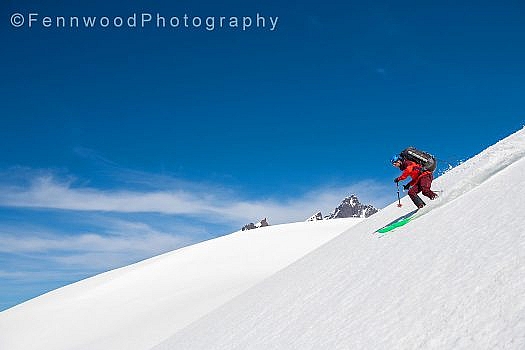
Skiing with a full pack after a long night. Still fun! Photo by Fennwood Photography
We carefully packed up, made twenty fun turns on an open face directly below camp, and coasted down the drainage toward home. As we dropped below the walls of the moraine, the wind suddenly disappeared and we found ourselves in sweltering heat again. I stripped to my baselayer and kept going.
After this and several other trips with The North Face’s zip-neck top, it’s easily made my final list of clothing I’m taking to Denali. Let’s just hope I don’t take the wind with me too, as Denali from what I hear may have its own plans for that.
Specs for The North Face Wool Baselayer L/S Zip Neck:
Shop for The North Face baselayers here.
(Born into a family of tall and loud mountaineers among the glaciated spires of the Olympic Mountains, guest blogger Leif Whittaker blames his lack of skiing talent on his high center of gravity. He has twice climbed to the summit of Mount Everest and he currently works as a climbing ranger for the USFS on Mount Baker. His first book, My Old Man and the Mountain, was published in October 2016 by Mountaineers Books.)
(Thanks to Freya Fennwood for permission to publish her beautiful photos. Check out her website for more of her stunning images.)
Beyond our regular guest bloggers who have their own profiles, some of our one-timers end up being categorized under this generic profile. Once they do a few posts, we build a category. In any case, we sure appreciate ALL the WildSnow guest bloggers!

